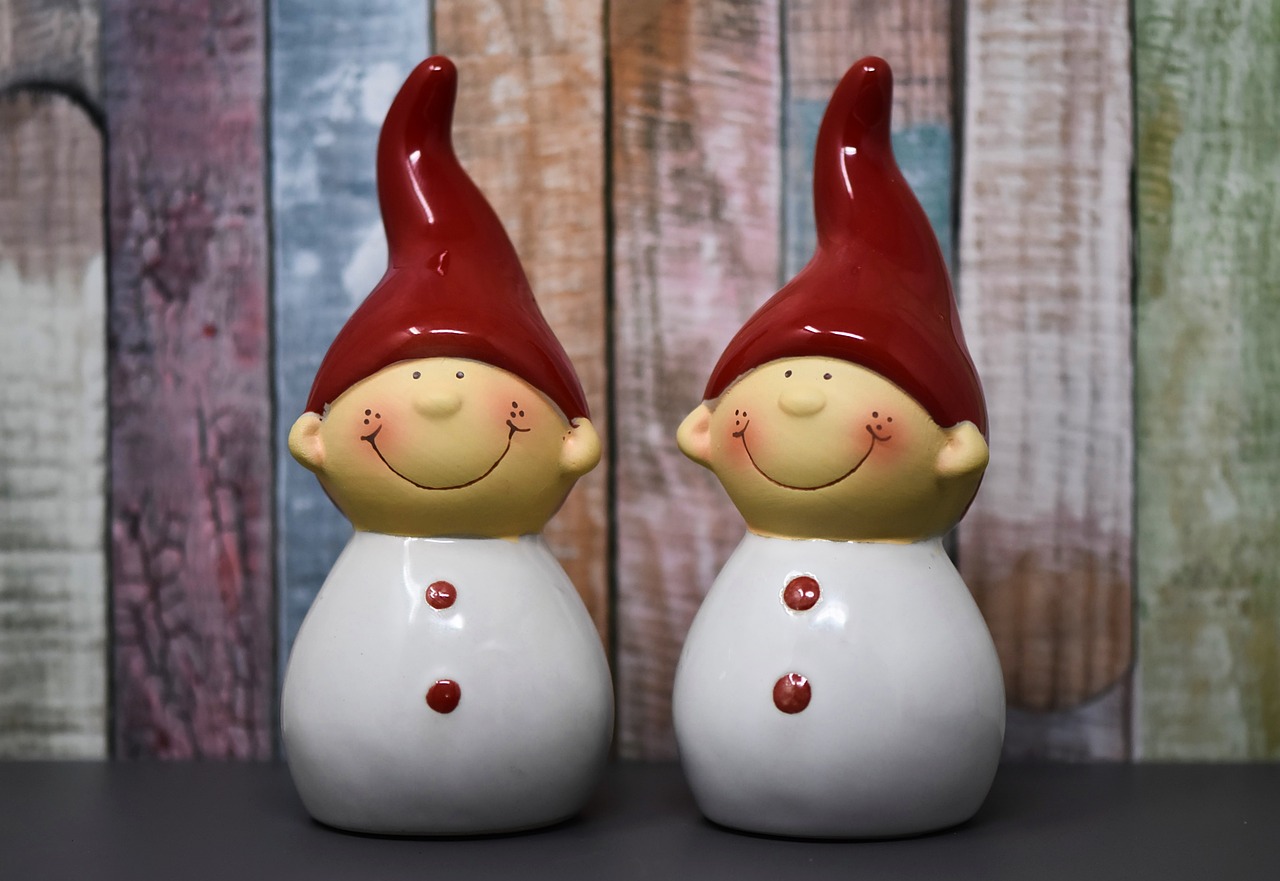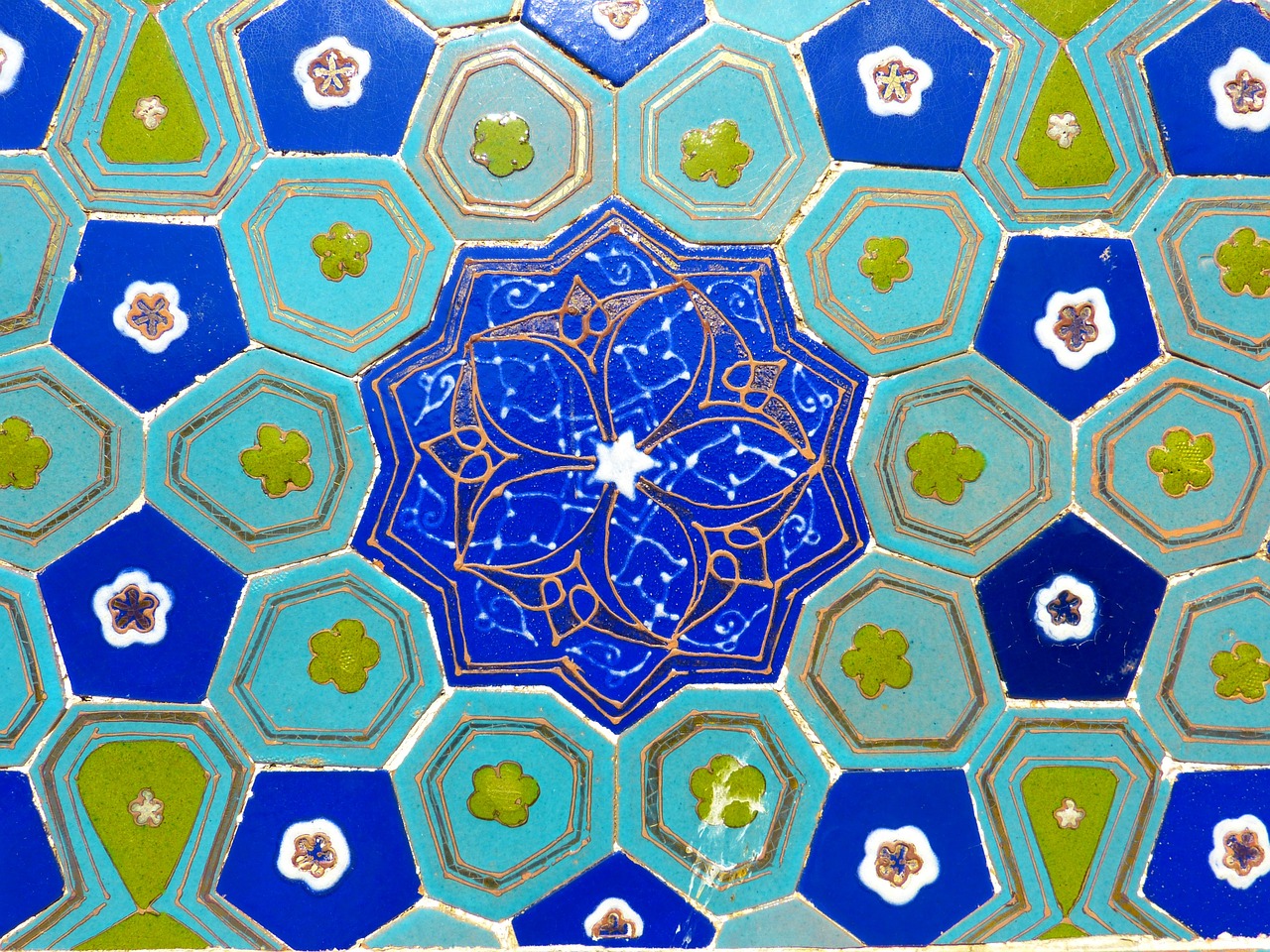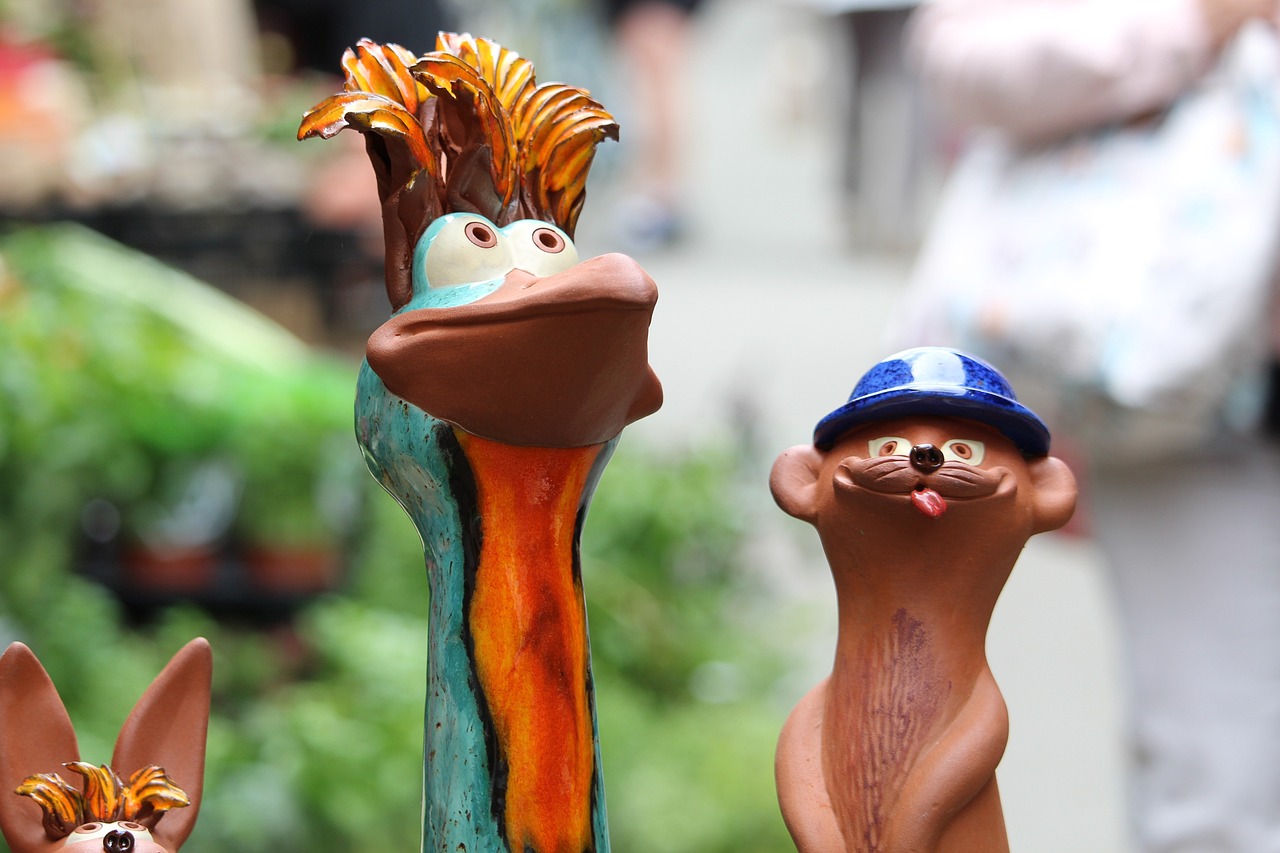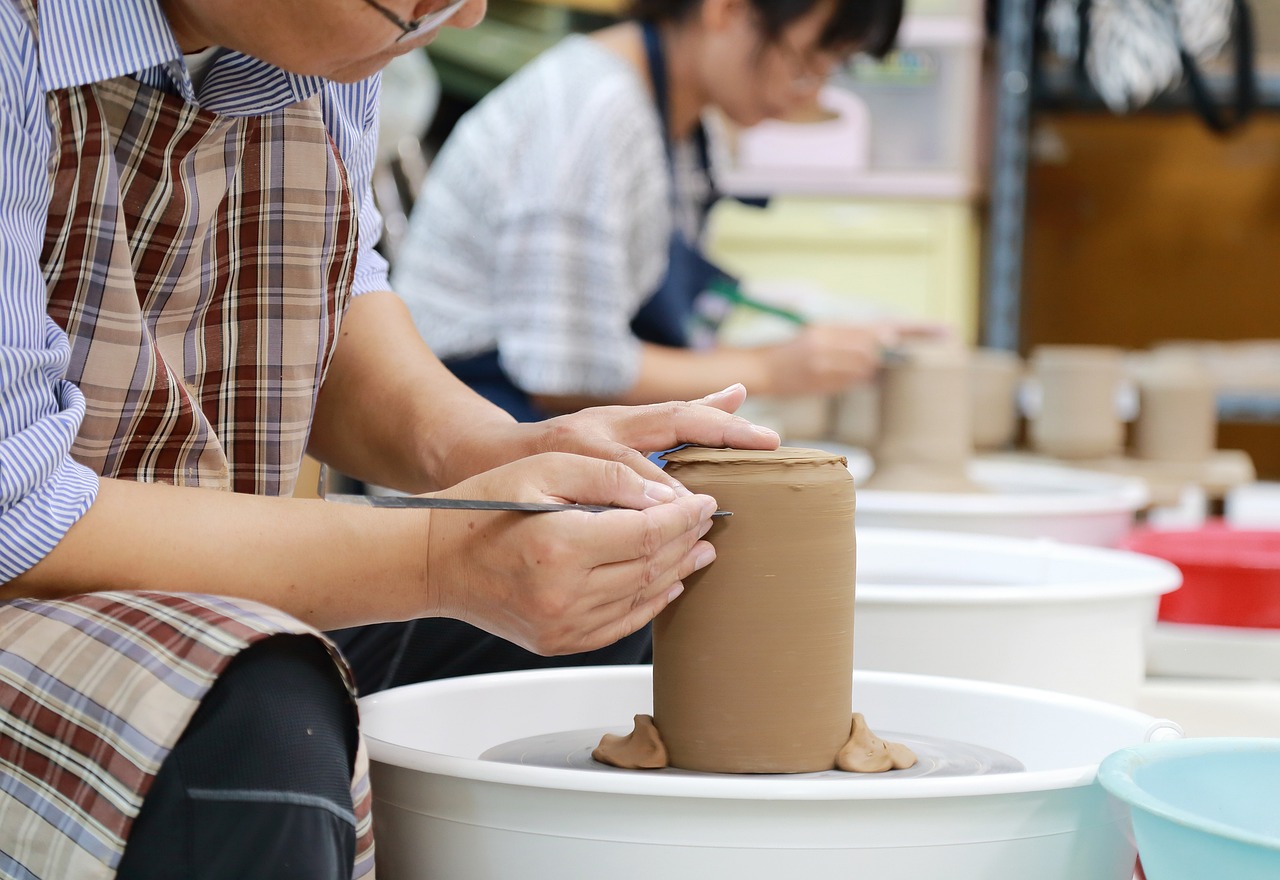Highlighting Inspiring Contemporary Ceramic Artists
In the vibrant world of art, ceramics stand as a testament to human creativity and innovation. Contemporary ceramic artists are not just potters; they are visionaries who challenge the boundaries of their medium. Their works are a fascinating blend of tradition and modernity, reflecting personal stories, cultural narratives, and environmental concerns. As we delve into the innovative realm of these artists, we will uncover the unique techniques they employ, the themes that inspire them, and their significant contributions to the art world.
Imagine walking into a gallery filled with stunning ceramic pieces that seem to tell a story. Each creation, whether it's a delicate vase or a bold sculptural form, invites you to explore its intricacies and the thought process behind it. These artists are redefining what it means to work with clay, pushing the limits of form and function. They are not afraid to experiment with textures, colors, and shapes, creating pieces that are as much about the experience of viewing as they are about the objects themselves.
What makes contemporary ceramics so exciting is the variety of approaches that artists take. Some focus on traditional techniques, infusing them with a modern twist, while others embrace cutting-edge technology to create pieces that would have been unimaginable just a few decades ago. They are not limited to the potter's wheel; instead, they explore methods such as 3D printing, slip casting, and hand-building. This fusion of old and new not only enhances their artistic expression but also brings a fresh perspective to the medium.
As we explore the world of contemporary ceramic artists, we will also highlight their backgrounds and signature styles. Each artist brings a unique perspective shaped by their experiences, cultural heritage, and personal journeys. From urban environments to rural landscapes, their surroundings play a crucial role in influencing their work. This article will showcase some of the most influential figures in the ceramic community, shedding light on the stories behind their creations and the impact they have on the art world.
In addition to individual artistry, the role of community in ceramics cannot be overstated. Collaborative spaces, workshops, and exhibitions are vital for nurturing creativity and supporting emerging talents. These environments foster a sense of belonging and encourage artists to share their knowledge and techniques with one another. By working together, they often create groundbreaking pieces that blend diverse styles and approaches, resulting in works that resonate on multiple levels.
Throughout this exploration, we will also discuss the importance of educational initiatives in the ceramic field. Programs aimed at teaching techniques and fostering a love for ceramics among aspiring artists are essential for the growth of the medium. By providing access to resources and mentorship, these initiatives ensure that the tradition of ceramic art continues to thrive in the hands of the next generation.
As we journey through the inspiring world of contemporary ceramic artists, prepare to be surprised and captivated by their innovative works and the profound messages they convey. Each piece is not just a product of skill but a reflection of the artist's soul, inviting us to engage with the medium in new and exciting ways.
- What defines contemporary ceramic art? Contemporary ceramic art is characterized by its innovative approaches, blending traditional techniques with modern materials and concepts.
- How do contemporary ceramic artists find inspiration? Many artists draw inspiration from personal experiences, cultural backgrounds, and environmental themes, which influence their creative process.
- What are some common techniques used in contemporary ceramics? Techniques such as slip casting, hand-building, glazing, and even 3D printing are commonly used by contemporary ceramic artists.
- Why is community important in the ceramic arts? Community fosters collaboration, creativity, and support among artists, helping to cultivate emerging talent and share knowledge.

[The Evolution of Ceramic Art]
Ceramic art has a rich and diverse history that stretches back thousands of years, evolving from simple utilitarian objects to complex, expressive forms that challenge our perceptions of art and functionality. Initially, ceramics were primarily created for practical purposes—think pots, dishes, and storage containers. These early pieces were often adorned with basic decorations, reflecting the culture and environment of the people who made them. As societies progressed, so did their ceramic techniques and styles, leading to the intricate and beautiful works we see today.
In ancient civilizations, such as those in Mesopotamia and Egypt, ceramics played a crucial role in daily life and rituals. The introduction of the potter's wheel around 3500 BCE marked a significant turning point, allowing for greater precision and uniformity in pottery production. Fast forward to the Middle Ages, and we see the emergence of glazed ceramics in Asia and Europe, which added a whole new dimension to the art form. These advancements paved the way for the stunning porcelain pieces that would later captivate collectors and art enthusiasts alike.
By the 20th century, the art of ceramics began to shift dramatically. Artists started to experiment with form and function, breaking away from traditional practices. This period saw the rise of studio pottery, where individual artists created unique pieces rather than mass-produced items. The movement was characterized by a focus on craftsmanship and personal expression, allowing artists to infuse their works with their distinct styles and philosophies.
Today, contemporary ceramic artists continue to push boundaries, exploring innovative techniques and materials. They challenge the status quo by integrating technology, mixed media, and conceptual ideas into their work. This evolution is not just about aesthetics; it reflects broader themes in society, such as sustainability and cultural identity. For instance, many artists now incorporate recycled materials into their ceramics, promoting environmental consciousness while creating stunning pieces that tell a story.
The journey of ceramic art is a testament to human creativity and adaptability. As we look to the future, it’s exciting to think about how this ancient medium will continue to evolve, merging tradition with modernity in ways we have yet to imagine.

[Notable Contemporary Ceramic Artists]
When we think of ceramic art, it's easy to envision quaint pottery or traditional vases. However, the contemporary scene is bursting with vibrant, innovative artists who are reshaping our understanding of what ceramics can be. These artists are not just creating functional pieces; they are crafting narratives, exploring themes, and pushing boundaries that challenge our perceptions. Let's dive into the lives and works of some of the most influential ceramic artists today.
One such artist is Grayson Perry, known for his provocative and often humorous works. Perry's ceramic pieces are not just visually striking; they tell stories that reflect his views on society, culture, and identity. He often incorporates intricate patterns and vibrant colors that draw viewers in, inviting them to ponder the deeper messages behind his art. Perry's ability to blend traditional ceramic techniques with contemporary themes makes him a standout figure in the art world.
Another remarkable artist is Elisabeth H. McCausland, whose work focuses on the connection between nature and human experience. McCausland creates stunning sculptures that mimic organic forms, often using earthy tones and textures that evoke a sense of calm and introspection. Her pieces encourage viewers to reflect on their relationship with the natural world, fostering a deeper appreciation for the environment. Through her art, McCausland brings awareness to ecological issues while showcasing the beauty of ceramics.
Rachael Colley is also making waves in the ceramic community with her unique approach to functionality and aesthetics. Colley's work often blurs the line between art and everyday objects, creating pieces that are both beautiful and practical. Her use of color and form challenges traditional notions of tableware, making each piece a conversation starter. By reimagining functional items, Colley encourages us to see the artistry in our daily lives.
To highlight these artists further, let’s take a look at a brief comparison of their unique styles and contributions:
| Artist | Signature Style | Themes Explored |
|---|---|---|
| Grayson Perry | Provocative, colorful, narrative-driven | Society, culture, identity |
| Elisabeth H. McCausland | Organic forms, earthy tones | Nature, human experience, ecology |
| Rachael Colley | Functional art, vibrant colors | Everyday life, aesthetics, conversation |
These artists are just a few examples of the incredible talent in the contemporary ceramic scene. Their works not only showcase technical skill but also invite us to engage with the world around us in new and meaningful ways. By blending traditional techniques with modern themes, they are redefining the boundaries of ceramic art and inspiring a new generation of creators.
As we explore the diverse landscape of contemporary ceramics, it's clear that these artists are not just makers; they are storytellers, provocateurs, and visionaries. Their contributions are pivotal in shaping the future of ceramic art, making it an exciting field to watch. So, whether you're a seasoned collector or a curious newcomer, keep an eye on these artists and the vibrant community they represent.
- What defines contemporary ceramic art? Contemporary ceramic art is characterized by its innovative techniques, diverse themes, and the blending of functionality with artistic expression.
- Who are some influential contemporary ceramic artists? Notable artists include Grayson Perry, Elisabeth H. McCausland, and Rachael Colley, each bringing unique perspectives and styles to the medium.
- How can I get involved in the ceramic art community? Consider taking workshops, attending exhibitions, or joining local art groups to connect with other artists and enthusiasts.

[Innovative Techniques in Ceramics]
In the vibrant world of contemporary ceramics, artists are not just shaping clay; they are redefining the very essence of what ceramic art can be. The techniques employed by these innovative creators are as diverse as their inspirations, ranging from traditional methods to cutting-edge technologies. Each technique offers a unique avenue for expression, allowing artists to explore their creativity in ways that challenge the limits of the medium.
One of the most popular techniques is slip casting, a method that involves pouring liquid clay, or slip, into a plaster mold. This technique allows for the creation of intricate shapes and fine details that might be impossible to achieve through hand-building alone. Artists like Grayson Perry have mastered this method, using it to produce complex forms that often carry deep cultural and personal narratives. The fluidity of slip casting opens up a world of possibilities, enabling artists to push the boundaries of traditional ceramics.
On the other hand, hand-building remains a cherished technique among many ceramicists. This method involves shaping the clay by hand, allowing for a tactile connection between the artist and their work. Techniques such as coiling, pinching, and slab building enable artists to create unique pieces that reflect their individual styles. For instance, Jennifer McCurdy utilizes hand-building techniques to produce delicate, lace-like porcelain forms that evoke a sense of fragility and beauty, showcasing the intimate relationship between the maker and the material.
Another innovative approach is the use of glazing, which not only adds color and texture but also enhances the functionality of ceramic pieces. The glazing process can transform a simple bowl into a stunning work of art, with layers of color and intricate patterns that catch the eye. Artists like John Britt have explored the chemistry of glazes, experimenting with different materials to create unique surface effects that challenge conventional aesthetics. The interplay of light and texture in glazed ceramics can evoke emotions and tell stories, making each piece a conversation starter.
Moreover, contemporary ceramic artists are increasingly incorporating technology into their work. Techniques such as 3D printing are revolutionizing the field, allowing for the creation of complex designs that were once thought impossible. This method enables artists to experiment with form and structure in ways that traditional techniques cannot. For example, artists like Jesse Wine utilize 3D printing to create playful and unexpected ceramic forms that challenge the viewer's perception of functionality and art.
In addition to these methods, many artists are also exploring the intersection of ceramics and other mediums. By combining ceramics with textiles, glass, or even digital media, they create hybrid works that expand the possibilities of artistic expression. This cross-disciplinary approach not only enriches the ceramic art form but also invites viewers to engage with the work on multiple levels.
Ultimately, the innovative techniques employed by contemporary ceramic artists are not just about creating visually stunning pieces; they are about pushing the boundaries of what ceramics can represent. Each technique tells a story, reflecting the artist's journey and the cultural dialogues that inform their work. As we continue to witness the evolution of ceramics, it is clear that the future of this medium is bright and full of potential.
- What is slip casting? Slip casting is a technique where liquid clay is poured into a plaster mold to create intricate shapes.
- How does hand-building differ from wheel throwing? Hand-building involves shaping clay by hand, while wheel throwing uses a potter's wheel to form pieces.
- Can technology be used in ceramics? Yes, techniques like 3D printing are being used to create complex ceramic forms that challenge traditional methods.
- What role does glazing play in ceramics? Glazing adds color, texture, and functionality to ceramic pieces, enhancing their visual appeal and usability.

[Sculptural Ceramics]
Sculptural ceramics represent a fascinating intersection of art and function, where the boundaries of traditional pottery are pushed into realms of imaginative expression. These artists are not just creating objects; they are crafting stories, emotions, and experiences that resonate deeply with viewers. Imagine walking through a gallery filled with ceramic pieces that seem to breathe, twist, and dance—each sculpture inviting you to engage not just with your eyes, but with your entire being. This is the magic of sculptural ceramics.
Many contemporary ceramic artists embrace experimental techniques to create their sculptural works, often combining various materials and methods that challenge conventional aesthetics. For instance, some artists incorporate mixed media, blending ceramics with metal, glass, or even textiles, which adds layers of texture and meaning to their pieces. Others explore the use of unconventional firing methods, such as pit firing or raku, which can produce unexpected colors and surface textures, further enhancing the narrative quality of their work.
One notable example is the work of Grayson Perry, whose ceramic sculptures often reflect societal themes and personal narratives. His pieces are not just visually striking; they provoke thought and discussion about identity, gender, and culture. Perry's ability to merge traditional ceramic techniques with contemporary themes exemplifies how sculptural ceramics can serve as a powerful medium for social commentary.
In addition to individual expression, sculptural ceramics often invite viewers to interact with them in unique ways. Many artists design their pieces to be touched or manipulated, breaking the traditional barrier between art and audience. This tactile engagement creates a more profound connection, allowing people to experience the art on a sensory level. Consider the works of Rachael Wong, who creates large-scale installations that encourage viewers to walk through and around her sculptures, immersing them in a world of color and form.
Moreover, the themes explored in sculptural ceramics are as diverse as the artists themselves. Nature, mythology, and personal history are just a few of the sources of inspiration that drive these creators. For example, artist Maria Martinez draws on Native American traditions, infusing her sculptural works with cultural significance and storytelling. Through her art, she preserves and reinterprets her heritage, making her pieces resonate with both personal and collective narratives.
Ultimately, sculptural ceramics challenge us to rethink our relationship with art. They invite us to look beyond mere aesthetics and consider the deeper meanings and emotions embedded within each piece. This dynamic art form not only enriches the ceramic community but also elevates the conversation around contemporary art as a whole.
- What is sculptural ceramics? Sculptural ceramics refer to three-dimensional ceramic artworks that often emphasize artistic expression over functionality.
- How do artists create sculptural ceramics? Artists use various techniques, including hand-building, slip casting, and innovative firing methods, to create unique sculptural pieces.
- Can sculptural ceramics be functional? While many sculptural ceramics are purely artistic, some pieces may also serve functional purposes, merging beauty with utility.
- What themes are common in sculptural ceramics? Artists often explore themes such as nature, culture, identity, and personal experiences in their sculptural works.

[Functional Art]
When we think about ceramics, the first images that often pop into our minds are those of beautiful vases or intricate sculptures. However, there’s a whole other side to this art form that is just as captivating: functional art. This is where beauty meets utility, and it's a realm where contemporary ceramic artists truly shine. Imagine sipping your morning coffee from a mug that is not only practical but also a piece of art in its own right. This is the magic of functional ceramics!
Functional art in ceramics is all about creating pieces that serve a purpose while also being visually stunning. Artists take everyday objects—like plates, bowls, and mugs—and elevate them into the realm of art. They play with form, color, and texture, transforming mundane items into extraordinary experiences. The beauty of functional ceramics lies in their duality; they are designed for use, yet they invite admiration and provoke thought.
Many contemporary ceramicists are redefining what it means to be functional. For instance, consider the work of artists like Jenna Gribbon and Ben Medansky, who incorporate playful shapes and vibrant glazes into their tableware. Their pieces not only serve as dinnerware but also as conversation starters, challenging the viewer to reconsider their relationship with everyday objects. This approach encourages people to appreciate the artistry involved in the items they use daily, transforming routine moments into something special.
Moreover, the process of creating functional ceramics is an art form in itself. Artists often experiment with various techniques to achieve the desired effect. For example, glazing plays a pivotal role in the final aesthetic of a ceramic piece. The choice of glaze can enhance colors, create textures, and even influence the piece's functionality—some glazes are food-safe, while others are not. This meticulous attention to detail ensures that each piece is not only beautiful but also practical.
To illustrate the diversity within functional ceramics, let's take a look at some common types of functional art:
| Type | Description |
|---|---|
| Mugs | Handcrafted mugs that are both unique and comfortable to hold, often featuring intricate designs. |
| Bowls | Artistic bowls that can serve as centerpieces or functional items for serving food. |
| Plates | Decorative plates that can be used for dining or displayed as wall art. |
| Vases | While primarily decorative, many vases can also serve functional roles in holding flowers or other items. |
In the world of functional ceramics, the possibilities are endless. Artists are constantly pushing boundaries, experimenting with new materials and techniques to create pieces that resonate with users on multiple levels. Whether it’s a hand-thrown bowl that feels perfect in your hands or a plate that transforms a simple meal into a feast for the eyes, functional art in ceramics invites us to engage with our everyday lives in a more meaningful way.
Ultimately, functional ceramics remind us that art doesn’t have to be confined to galleries or museums. It can exist in our homes, enhancing our daily routines while sparking joy and creativity. So the next time you reach for a ceramic mug or plate, take a moment to appreciate the artistry behind it. After all, in the world of functional art, every piece tells a story!
- What is functional art in ceramics? Functional art in ceramics refers to ceramic pieces that are designed for practical use while also being aesthetically pleasing.
- How do artists create functional ceramics? Artists use various techniques such as hand-building, wheel-throwing, and glazing to create functional ceramics that are both beautiful and usable.
- Can functional ceramics be used in everyday life? Yes! Many functional ceramic pieces are designed for everyday use, such as dinnerware, mugs, and bowls.

[Themes and Inspirations]
Contemporary ceramic artists are like storytellers, weaving tales through their clay creations. The themes and inspirations that drive their work often reflect the world around us, tapping into a rich tapestry of experiences, emotions, and cultural narratives. Many artists draw from the beauty of nature, capturing its essence in their pieces, whether it's the delicate curves of a flower or the rugged textures of a rocky landscape. This connection to the natural world not only enhances the aesthetic appeal of their work but also serves as a reminder of our relationship with the environment.
Another significant source of inspiration comes from cultural heritage. Artists often explore their roots, incorporating traditional motifs and techniques into their contemporary works. This fusion of old and new not only honors their ancestry but also challenges viewers to reconsider the boundaries between tradition and modernity. For example, some artists might use ancient glazing techniques while experimenting with modern forms, creating a dialogue between the past and present.
Furthermore, personal experiences and emotions play a crucial role in shaping the narratives behind ceramic art. Artists often channel their feelings—be it joy, sorrow, or nostalgia—into their creations, making each piece a reflection of their inner world. This emotional depth can be particularly powerful, inviting viewers to engage with the work on a more intimate level. For instance, an artist might create a series of vessels that symbolize the journey of healing after a loss, using color and form to express the complexities of grief.
In addition to these inspirations, contemporary ceramic artists frequently address pressing social issues through their work. Themes such as identity, gender, and environmental sustainability are increasingly prevalent. By incorporating these themes, artists not only raise awareness but also provoke thought and discussion among their audience. For example, an artist might create a piece that critiques consumerism by using found objects in their ceramic work, challenging the notion of value in art and everyday life.
To summarize, the themes and inspirations behind contemporary ceramic art are as diverse as the artists themselves. From the natural world and cultural heritage to personal experiences and social commentary, these influences create a rich tapestry that resonates with viewers. As we explore these layers of meaning, we gain a deeper appreciation for the artistry and intention behind each piece.
- What are some common themes in contemporary ceramic art? Contemporary ceramic art often explores themes such as nature, cultural heritage, personal experiences, and social issues.
- How do artists incorporate their cultural backgrounds into their work? Many artists blend traditional motifs and techniques from their heritage with modern styles, creating a dialogue between the past and present.
- Can ceramics be both functional and artistic? Absolutely! Many artists create functional pieces that are also visually stunning, merging beauty with utility.
- How can I support emerging ceramic artists? You can support them by attending exhibitions, purchasing their work, or participating in workshops and community events.

[The Role of Community in Ceramics]
Community plays a vital role in the development and success of ceramic artists. It’s not just about creating art; it’s about creating connections. Think of the ceramic community as a vibrant tapestry, woven together by shared experiences, knowledge, and passion for the medium. These connections foster creativity and innovation, allowing artists to explore new ideas and techniques that they might not have ventured into alone.
In many ways, the ceramic community acts as a nurturing ground for emerging talents. Collaborative spaces, workshops, and exhibitions provide platforms for artists to share their work, receive feedback, and learn from one another. Imagine stepping into a bustling studio filled with the sounds of laughter, clinking clay, and the whirring of pottery wheels. This is where magic happens—where seasoned artists mentor novices, and fresh perspectives invigorate traditional practices.
A significant aspect of this community is the sense of belonging it fosters. Artists often find themselves surrounded by like-minded individuals who understand the challenges and triumphs of working with clay. This support network can be incredibly empowering, especially in an industry that can sometimes feel isolating. By participating in community events, artists not only showcase their work but also build lasting relationships that inspire and motivate them to push their creative boundaries.
Moreover, community-driven initiatives often lead to exciting collaborations. These partnerships can combine different artistic styles and techniques, resulting in innovative works that reflect a fusion of ideas. For instance, when two artists from diverse backgrounds come together, they might create a piece that tells a story, blending cultural influences in a way that resonates with a broader audience. Such collaborations can be transformative, both for the artists involved and for the viewers who experience their work.
Here are some ways community impacts ceramic artists:
- Workshops: These provide hands-on learning experiences where artists can refine their skills and experiment with new methods.
- Exhibitions: Showcasing work in communal spaces allows artists to gain visibility and connect with potential buyers and collectors.
- Support Networks: Artists can share resources, advice, and encouragement, which is crucial for personal and professional growth.
Additionally, educational initiatives within the community play a crucial role in nurturing the next generation of ceramic artists. Programs aimed at teaching ceramic techniques often include workshops, classes, and mentorship opportunities that can ignite a passion for the medium in young aspiring artists. These initiatives not only help preserve traditional techniques but also encourage experimentation and innovation, ensuring that the art form continues to evolve.
In conclusion, the community surrounding ceramic art is not just a backdrop; it’s an essential part of the creative process. It provides a supportive environment where artists can thrive, collaborate, and push the boundaries of what is possible within the medium. The relationships formed in these spaces can lead to groundbreaking work and a richer, more diverse ceramic landscape that continues to inspire both creators and audiences alike.
Q: How can I get involved in the ceramic community?
A: You can start by attending local workshops, joining ceramic clubs, or participating in community exhibitions. Engaging with other artists can help you build valuable connections.
Q: What are some benefits of collaborating with other artists?
A: Collaborations can lead to innovative works that blend different styles and techniques, providing fresh perspectives and expanding your creative horizons.
Q: Are there educational programs for aspiring ceramic artists?
A: Yes! Many communities offer workshops, classes, and mentorship programs aimed at teaching ceramic techniques and fostering a love for the medium among new artists.

[Artistic Collaborations]
In the world of contemporary ceramics, artistic collaborations stand out as a vibrant testament to the power of creativity and community. When artists come together, they fuse their unique styles, techniques, and perspectives, resulting in pieces that are not just artworks but also conversations in clay. These collaborations often challenge the norms of traditional ceramics, pushing boundaries and inviting viewers to engage in a dynamic dialogue.
One of the most fascinating aspects of these partnerships is how they can lead to unexpected outcomes. For instance, when a sculptor collaborates with a potter, the result might be a stunning piece that balances form and function, combining the intricacies of sculpture with the utility of pottery. This blending of disciplines creates a rich tapestry of creativity that is both innovative and refreshing.
Take, for example, the collaboration between the renowned ceramic artist Sharon Silverman and the talented painter Markus Lehn. Their joint project, titled “Fusion of Forms,” showcases how ceramics can be transformed into a canvas for vibrant colors and intricate designs. By intertwining their crafts, they have created a series of ceramic bowls that not only serve a practical purpose but also serve as stunning art pieces that draw the eye and spark conversation.
Moreover, collaborations often extend beyond the individual artists involved. They can foster a sense of community, encouraging other artists to explore new ideas and techniques. In many cases, these partnerships are born out of workshops or community art spaces where artists can experiment and share their knowledge. The resulting works often reflect a blend of influences, showcasing the diverse backgrounds and experiences of the artists involved.
To illustrate the impact of artistic collaborations in ceramics, consider the following table that highlights some notable partnerships and their contributions to the field:
| Artists | Project Title | Description |
|---|---|---|
| Sharon Silverman & Markus Lehn | Fusion of Forms | A series of ceramic bowls featuring vibrant colors and intricate designs, merging pottery with painting. |
| Emily Chen & David Park | Earth & Sky | A sculptural installation that explores themes of nature, combining ceramic elements with mixed media. |
| Laura Kim & Tomás Rivera | Voices in Clay | A collaborative exhibition showcasing the cultural narratives expressed through their ceramic works. |
These collaborations not only enrich the artists' portfolios but also contribute to the broader ceramic community by inspiring emerging talents. When seasoned artists share their expertise and techniques with others, they help cultivate a new generation of creators who are eager to explore the endless possibilities of ceramics.
In conclusion, artistic collaborations in the realm of ceramics are more than just partnerships; they are a celebration of creativity, innovation, and community. By working together, artists can transcend the limitations of their individual practices, creating works that resonate on multiple levels and invite viewers to experience the beauty and complexity of the medium in new and exciting ways.
- What is the significance of artistic collaborations in ceramics? Artistic collaborations enhance creativity and innovation, leading to unique works that blend different styles and techniques.
- How do collaborations impact emerging ceramic artists? Collaborations provide mentorship opportunities and inspire new artists to experiment with their craft.
- Can you give examples of successful ceramic collaborations? Yes, projects like "Fusion of Forms" and "Earth & Sky" highlight the successful blending of different artistic disciplines.

[Educational Initiatives]
In the vibrant world of ceramics, educational initiatives play a crucial role in shaping the future of the art form. These programs are not just about teaching techniques; they are about igniting a passion for creativity and fostering a community of artists who can push the boundaries of what ceramics can be. From workshops to formal education, these initiatives are the lifeblood of the ceramic community, ensuring that the art form continues to evolve and thrive.
One of the most exciting aspects of these educational programs is their ability to make ceramics accessible to everyone, regardless of skill level. Many community centers and art schools offer introductory classes that cover the basics of clay handling, glazing, and firing techniques. For instance, a typical beginner's course might include:
- Introduction to different types of clay
- Basic hand-building techniques
- Understanding glazing and its effects
- Firing processes and safety measures
These classes are often taught by experienced ceramic artists who share their insights and personal stories, making the learning experience not only informative but also deeply personal. Imagine learning how to mold your first bowl while listening to the instructor recount their journey of becoming a renowned artist; it’s this kind of inspiration that can spark a lifelong passion.
Moreover, more advanced workshops delve into specialized techniques such as slip casting, wheel throwing, and even sculptural ceramics. These sessions provide artists with the opportunity to refine their skills and explore new avenues of creativity. For example, a workshop on slip casting might cover:
| Workshop Component | Description |
|---|---|
| Material Selection | Understanding different types of slip and their uses. |
| Mold Making | Creating and using molds for casting. |
| Finishing Techniques | How to finish and glaze cast pieces. |
In addition to hands-on workshops, many organizations also host exhibitions and competitions that encourage participants to showcase their work. These events not only provide exposure but also foster a sense of community among artists. They allow emerging talents to connect with established artists, share ideas, and receive constructive feedback, which is invaluable for growth.
Furthermore, educational initiatives often extend beyond traditional classroom settings. Online platforms have emerged, offering virtual workshops and tutorials that reach a global audience. This shift has democratized access to ceramic education, allowing aspiring artists from all walks of life to learn from the comfort of their homes. The ability to watch a master potter demonstrate a technique in real-time can be a game-changer for many.
In conclusion, educational initiatives in ceramics are vital for nurturing creativity and skill development. They provide a supportive environment where artists can explore their potential, share their experiences, and contribute to the rich tapestry of contemporary ceramic art. As we continue to support these programs, we ensure that the future of ceramics remains bright and full of possibility.
- What types of educational programs are available for aspiring ceramic artists? There are various programs, including community workshops, online courses, and formal education at art schools.
- Do I need prior experience to join a ceramics class? No, many classes cater to beginners and provide all the necessary materials and guidance.
- How can I find workshops in my area? You can check local community centers, art schools, or online platforms that list upcoming events.
Frequently Asked Questions
- What is contemporary ceramic art?
Contemporary ceramic art refers to the innovative and expressive works created by artists using clay and other ceramic materials. It encompasses a wide range of styles and techniques, often challenging traditional notions of pottery and merging art with functionality.
- How has ceramic art evolved over the years?
Ceramic art has transformed significantly from its roots in traditional pottery to modern artistic expressions. This evolution reflects changes in culture, technology, and artistic intent, allowing artists to explore new themes and techniques that push the boundaries of the medium.
- Who are some notable contemporary ceramic artists?
There are many influential ceramic artists today, each with a unique style and perspective. Some notable names include Grayson Perry, who combines ceramics with social commentary, and Ai Weiwei, known for his politically charged installations. Their work showcases the diversity and depth of contemporary ceramics.
- What innovative techniques do contemporary ceramic artists use?
Artists employ various techniques such as slip casting, hand-building, and glazing to create their works. These methods allow for greater creativity and expression, enabling artists to explore textures, forms, and colors in ways that were not possible in traditional pottery.
- What is the significance of sculptural ceramics?
Sculptural ceramics blur the lines between art and function, inviting viewers to engage with the medium in a deeper way. Artists create thought-provoking pieces that often convey messages or emotions, making sculptural ceramics a vital part of contemporary art.
- Can ceramics be both functional and artistic?
Absolutely! Many contemporary ceramic artists create functional pieces, such as tableware, that are not only beautiful but also practical. This merging of art and utility highlights the craftsmanship involved and enhances the everyday experience of using these objects.
- What themes inspire contemporary ceramic artists?
Contemporary ceramic artists draw inspiration from a variety of themes, including nature, personal experiences, and cultural narratives. These influences shape their work, allowing them to convey deeper meanings and connect with audiences on multiple levels.
- How does community impact ceramic artists?
Community plays a crucial role in the development of ceramic artists. Collaborative spaces, workshops, and exhibitions foster creativity, provide support, and help emerging talents connect with established artists, enriching the ceramic art scene.
- What are some examples of artistic collaborations in ceramics?
Artistic collaborations often lead to groundbreaking work in ceramics. For instance, partnerships between sculptors and functional potters can result in unique pieces that blend different styles and techniques, showcasing the power of collaboration in the art world.
- How can aspiring ceramic artists get involved in educational initiatives?
Aspiring ceramic artists can participate in various educational programs and workshops offered by art schools, community centers, and local studios. These initiatives are designed to teach ceramic techniques and inspire a love for the medium, helping to nurture the next generation of artists.



















